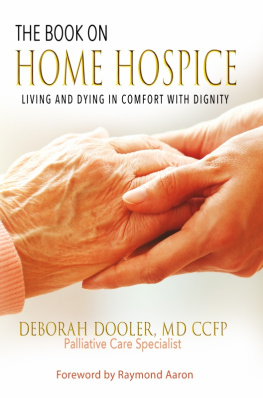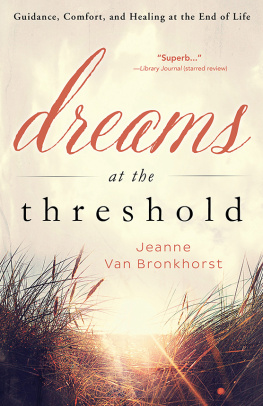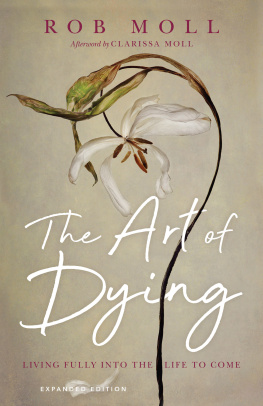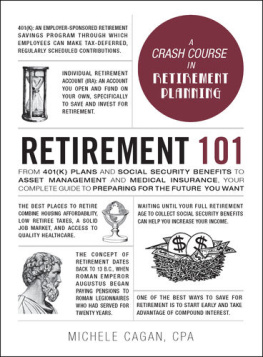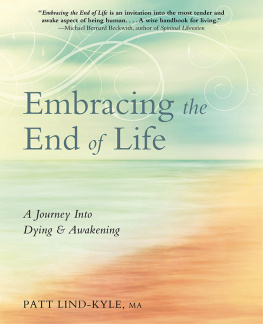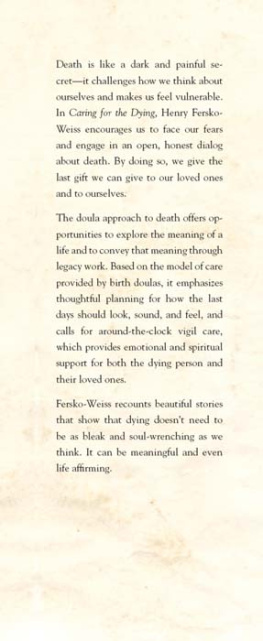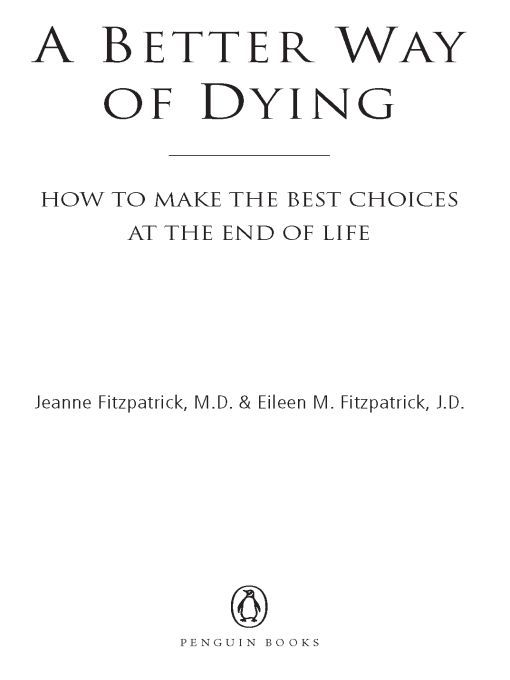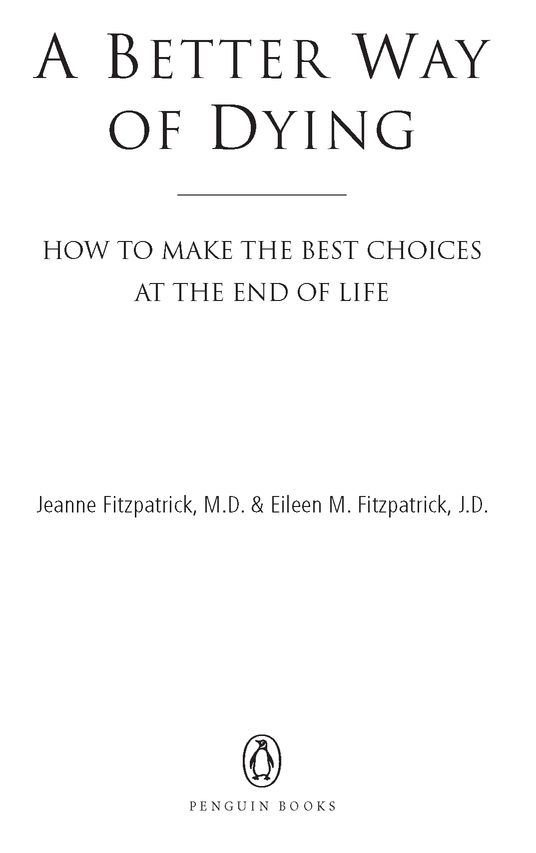Table of Contents
A BETTER WAY OF DYING
The authors are sisters who have studied the medical and legal issues surrounding end-of-life policy since it first began to surface at conferences and in academic journals in the 1980s. DR. JEANNE FITZPATRICK has practiced emergency medicine in small cities and rural areas around the country for over twenty-five years. She currently lives outside of Salem, Oregon, and works in the Emergency Department at Santiam Memorial Hospital in Stayton, Oregon. EILEEN M. FITZPATRICK, a graduate of Harvard Law School, practiced corporate law in Boston prior to moving to rural New England to pursue a career in writing. She lives in Dana Point, California, where she is active in local politics.
A thoughtful and heartfelt book that exposes an alarming truth about end-of-life care in America, one that every physician who has cared for the dying knows: Even when patients do everything right to assure that these intensely personal preferences are honored, theres still much that can go wrong. Intent on preventing such injustices, the authors have articulated a pragmatic step-by-step approach you can use to make sure this doesnt happen to you. Ill be sharing this book with many patients.
Mark Lachs, MD, MPH, Professor of Medicine, Weill Medical College of Cornell University
Lovingly and gratefully dedicated to
Craig Wesley Fitzpatrick and Lois Fitzpatrick Briley
Foreword
Consider for a moment how unusual in many ways are the questions raised in A Better Way of Dying.
Go back just forty years ago, and there were no Living Wills, no health care powers of attorney, no 911 to call, no diagnosis of persistent vegetative state/permanent unconsciousness, no state laws defining death, nothing called a DNR order. (In 1966, the National Academy of Sciences first recommended that doctors begin learning a new technique called CPR. The very idea of any need to pair the words do not with resuscitate was decades away.) Back then the issues addressed by this book did not yet exist. Seriously ill patients took all the treatment the doctor had to offer, and either got better or died. No questions about the appropriateness of treatment were needed or asked. All treatment available was given and accepted gladly.
The rapid advance of medical technology has changed that dynamic forever. That change, on balance, is of course for the good. Americans are not only living longer, but we are also thriving as we age. And with that thriving has come a new set of circumstances at the end of our lives. Dying happens differently today than it did forty years ago. The idea of letting nature take its course has fallen by the wayside from both the medical and technological perspectives. Most deaths now happen in institutions, and most are the result of a decisionantibiotics refused, respirators turned off, feeding tubes clamped. And while the technology that keeps us alive grows ever more complex, the questions about when it is appropriate to use that technology are in many ways basic, fundamental human questions that all of us will benefit from discussing: What is the purpose of medicine? When do we use it? And when should we stop?
Interestingly, though perhaps not surprisingly, much of the societal discussion about how we navigate decisions at the end of life has played out through our legal system. I have been involved in that discussion since the spring of 1987, when I became the lawyer for Nancy Cruzan and her family. Nancys tragic case ultimately ended up in the U.S. Supreme Court, where in 1990 the Court established the right of Americans to make decisions about our own medical care, including whether we have the right to refuse treatmentwhat some call our right to die.
The law, however, is not the best venue to develop good decision making in medicine, since it typically scrambles to keep pace with science and technology. That truism certainly applies at the end of life. Legislators in Missouri who passed our first Living Will law in 1985 believed they were solving cases like Nancy Cruzans. So did federal lawmakers who passed the Patient Self-Determination Act in 1990. Various efforts in other stateshealth care powers of attorney, out-of-hospital DNR rules, decision-hierarchy lawshave all been aimed at such solving. There is no question that these laws give us tools, structure, rights, and guidance. But none of them can really resolve the hard, multifaceted questions we face at the end of life. The law is black and white, and those questions exist deep in the gray zones of society, where answers are seldom simple.
Yet answers to the questions do exist. This suggestion may sound way too simplistic, but after spending years working on end-of-life issues, Im convinced that our society will find the answers if we simply do a better job of talking with one another. Medical studies support this admittedly basic proposition. They show that patients who talk with their families and doctors end up with fewer unwanted ER and ICU visits in their final months of life. These patients often choose home care and hospice instead. They and their families routinely report higher satisfaction with the less technological path. And, perhaps surprising to many, various studies suggest that patients live about as long whether they choose the high-technological path of the hospital, home care, hospice, or other paths of less technological care.
In short, talking about our dying improves how we die.
Which brings me to A Better Way of Dying. In this book Dr. Jeanne Fitzpatrick and attorney Eileen Fitzpatrick develop a thorough and interesting new approach to facilitating that societal discussion. Using compelling stories of patients taken from Dr. Fitzpatricks practice of many years, they provide a detailed road map for talking about end-of-life careone that includes Alzheimers disease, nursing homes, feeding tubes, and many of the hard questions that modern medical technology is bringing to our society.
Do your loved ones a favor. Read A Better Way of Dying. Talk about the stories you encounter in the book. Expand the discussion about what youve learned beyond your loved onesto your doctor and minister and to others in your social circle who will care about how medical decisions might be made for you if accident or illness leaves you unable to speak on your own behalf. Write down who it is that you want to speak for you should this happen, and then arm that person to act as your advocatefor less treatment, more treatment, or different treatment.
What is the purpose of medicine? When do we use it? And when should we stop? Sharing your own answers to these questions is a gift to those you love. The stories in this book will help you give that gift. So, lets talk.
William Colby
Senior Fellow, Law and Patient Rights
Center for Practical Bioethics
www.PracticalBioethics.org
March 25, 2009
Prologue
ATTORNEY EILEEN FITZPATRICK
My sister, Dr. Jeanne Fitzpatrick, has a remarkable story to tell. She has worked as an emergency room physician in small, mostly rural towns in Alaska, Washington, Oregon, Hawaii, and New Mexico.
Unlike ER doctors on television, she rarely deals with multiple gunshot wounds or catastrophic freeway pileups. Instead, as many as a third of her patients are from local nursing homesthe infirm elderly, the demented, and the terminally ill.


